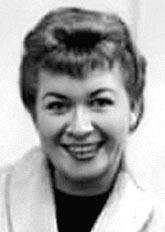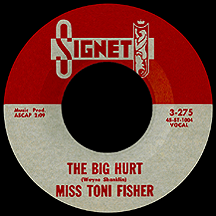MISS TONI FISHER
The Big Hurt
Wayne Shanklin was 35 when he scored his first major hit as a songwriter. On "Jezebel" he made his name, helping to keep the Hebrew princess's scandalous image alive through Frankie Laine's 1951 rendition of his composition. Other well-known Shanklin songs include the duet "Little Child" (adapted from a French song), with many recorded versions in the mid-'50s, the most popular by actor Eddie Albert with Sondra Lee and a tenderly touching version by 'Daddy Dear' Cab Calloway and his daughter, 'Little One' Lael Calloway, in 1956. He penned two really big ones later in the decade: "Chanson D'Amour," made famous by Art and Dotty Todd in '58, and "Primrose Lane" by Jerry Wallace the following year, cowritten with George Callender (on his own he came up with Wallace's next hit, "Little Coco Palm"). At about the same time, the decade came to a close with the baddest of Shanklin stunners, a sonic trick played on the ears: "The Big Hurt."
Toni Fisher spent most of the 1950s trying to make it as a singer, working small Los Angeles clubs while learning to live with rejection where the record companies were concerned. A demo recording she did of the Julie London hit "Cry Me a River" caught the attention of Shanklin, who had been struggling a bit in his efforts to get his own label, Signet Records, off the ground. She recorded "The Big Hurt" at L.A.'s Gold Star studios with Heinie Beau's orchestra, but Shanklin felt there was something missing; he wanted the song to stand out and worked with the studio's engineers to come up with what he called a "gimmick sound." The end result used a tape-delay phasing effect (some have called it "flanging") sounding not unlike the distant, slightly distorted echo of a short wave radio tuning in a faraway signal; the recording was fantastically freakish by '50s standards. Billed as Miss Toni Fisher (strange considering she was a Mrs. and used husband Bill Fisher's surname as her professional handle), she found herself with a fast-rising hit. It debuted mid-November, leaped into the top 40 a week later and spent most of December 1959 and January '60 in the top ten.
The cover of Miss Toni's Signet album The Big Hurt heralded the recording as "StereOmonic," though the title track was the only song on the LP to use the phasing technique (Billboard magazine referred to it simply as "outer space sound effects"). The device was reprised on her next single, Irving Berlin's "How Deep is the Ocean," apparently one flange too many; the record vanished into the stratosphere after two weeks on the charts in April. Other releases on Signet were ignored by radio programmers. Still, she was at last a hot property, at least for the time being, in demand at better venues including hotels and supper clubs. Songwriter Ray Gilbert (an Oscar winner, with Allie Wrubel, for "Zip-A-Dee Doo-Dah" from the 1947 Disney film Song of the South) composed music for her live act. Shanklin and Fisher continued working together as Columbia Records gave her a shot in 1961 on the basis of her hit. Bounced from the major label shortly afterward, she dropped the "Miss" from her name and returned to the charts once again with a social declaration linked to the news of the day.

The German Democratic Republic (East Germany to most of us), furthest west of the Eastern Bloc of Communist states, was plagued by a growing exodus of defectors between the end of World War II and the early '60s. So, in August 1961, the Berlin Wall was erected to prevent its citizens from leaving (at least that was the world's perspective; the East German government played a different angle). Families and friends were separated by this development, which received a great deal of press at the time. Shanklin composed a song addressing the dilemma of two lovers separated by the massive armed blockade; "West of the Wall" sensitively delineated the situation through Toni Fisher's yearning (and non-enhanced) vocal performance. The single, released on the Big Top label, was a top 40 hit in July 1962, well-timed to complement newspaper headlines and leadoff stories on The Huntley-Brinkley Report.
Unable to secure a successful follow-up hit, Toni (remaining Miss-less) moved from Big Top to Smash Records, where she and Shanklin spent most of 1963 attempting, without luck, to get back onto the charts. There were more Signet releases in the mid-'60s and eventually the team made its last stand at Capitol Records circa 1967. Wayne Shanklin's life ended abruptly in 1970 when he suffered a heart attack; Toni Fisher continued performing for awhile, eventually choosing family life over further showbiz struggles. "The Big Hurt" had already been revived by Del Shannon (in 1966) and has since been recorded by countless artists in many diverse genres. That "outer space" flanging trick introduced by her decade-bridging hit has gained popularity among rock music producers through the years. Jimi Hendrix, in a 1968 interview, cited the song as a favorite, saying, "All of the new techniques were used on that record without anyone knowing about it."


